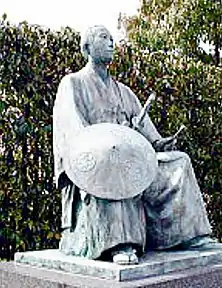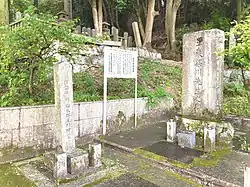Ikutaro Tokoro
Ikutaro Tokoro (所 郁太郎, Tokoro Ikutarō, March 11, 1838 – April 7, 1865) was a doctor practicing Western medicine and also a patriot in the closing days of the Tokugawa shogunate. He is well known as the doctor who saved the life of Inoue Kaoru, who was severely wounded by would-be assassins. He was also a staff officer of Takasugi Shinsaku.
Junior Fourth Rank, Lower Grade 所 郁太郎 Tokoro Ikutaro | |
|---|---|
 Statue of Ikutaro Tokoro in Akasaka-juku (Nakasendō), his birthplace | |
| Native name | Ikutaro Yabashi (矢橋 郁太郎) |
| Other name(s) |
|
| Born | March 11, 1838 Akasaka-juku (Nakasendō), Ōgaki Domain, Japan |
| Died | April 7, 1865 (aged 27) Yamaguchi (city), Chōshū Domain, Japan |
| Buried | |
| Allegiance | Chōshū Domain |
| court rank | Ju shi-i no ge (従四位下, Junior Fourth Rank, Lower Grade) |
| Commands held | Yugekitai (Chōshū Domain as the overseer) (軍監)) |
| Battles/wars | the Coup of August 18, 1863 Ikedaya incident Kinmon incident |
| Children | Sumen (す免) (real daughter) Minokichi (美吉) (adopted son, formerly Minokichi Yabashi) |
| Relations | Mataichi Yabashi (矢橋 亦一) (real father) Iori Tokoro (所 伊織) (adoptive father) Sue (すゑ) (granddaughter) |
Biography
Ikutaro Tokoro (ja), formerly Ikutaro Yabashi, was a doctor practicing Western medicine and a patriot in the closing days of the Tokugawa shogunate.
He was born in Akasaka-juku (Nakasendō) in 1838 as the 4th son of Mataichi Yabashi (矢橋亦一). Later this "Yabashi" family had to moved out of the homeland because Ikutaro became a supporter of the doctrine of restoring the emperor. At the age of 11 Ikutaro became the son-in-law of Iori Tokoro (所伊織) who also had to move out of the homeland for the very same reason.
Ikutaro entered into Tekijuku. He had the reputation of being a brilliant student and enjoyed the companionship of Fukuzawa Yukichi, Ōmura Masujirō and so on.[1]
He became the head of the Kyoto Residence of Chōshū Domain upon the recommendation of Katsura Kogorō (later Kido Takayoshi).
In 1864 Ikutaro succeeded in saving the life of Inoue Kaoru by sewing about 50 stitches of tatami needle in the wounds on the whole body without anesthesia because of emergency during the domestic war time. At that time Inoue Kaoru had been severely wounded by the attack of Zokuron-tō (Sodetogi-bashi Bridge (袖解橋) incident), received a near-fatal injury and had been appealing to Kaoru's brother for beheading right after the attack. The episode that then Inoue's mother, holding bloody Inoue, dissuaded his brother from beheading by saying "What's this? If he dies, he'll be unable to do his best for the country".
...Ikutaro said out loud, putting his mouth to Inoue Kaoru's ear, "I am Tokoro Ikutaro. Although you asked your elder brother for beheading, your mother forcibly stopped your elder brother from beheading to make you receive the operation, holding you by herself. Namely it is your mother that holds you at this moment. As you sustained really severe injuries, I'm not sure if my operation could be effective. But I cannot overlook your mother's painful feeling. You have to accept my operation and bear some pains for your mother's affection." It seemed that these words reached to the bottom of the ear of Duke Inoue and that he was deeply impressed. Immediately Ikutaro tucked up the sleeves of kimono with a tasuki, cleaned the wounds with shōchū and began to suture the wounds with the small tatami needle. Duke almost lost consciousness, so it seemed that the operation wasn't so painful for him. But when Ikutaro was suturing the wounds from right cheek to the lips, it seemed that he suffered pains...
This episode was introduced in the National Primary School Reader of the 5th Period. Before World War II everyone knew this episode.
Ikutaro became staff officer of Takasugi Shinsaku. It is said that Ikutaro Tokoro, temperate and elegant person, didn't fawn although he rendered good service to the country and Chōshū and that even Takasugi Shinsaku with a fiery temperament followed Ikutaro's opinions even if they were against Takasugi's will.
Ikutaro Tokoro died of typhoid in camp at the age of 27.[3]
He was enshrined in Kyoto Ryozen Gokoku Shrine in 1869.

Ikutaro Tokoro was awarded the title of ju shi-i no ge (従四位下, Junior Fourth Rank, Lower Grade) by the recommendation of Inoue Kaoru, Shinagawa Yajirō and so on.
Ikutaro was also awarded by the erection of the monument at the site of the demolished Tokoro's house in Ono Town, where Ikutaro as a member of the Tokoros grew up, with the cooperation of Marquis Inoue Saburō, grandson of Inoue Kaoru.[4]
Inoue Kaoru rehabilitated the extinct family, the Tokoros, by bringing up Ikutaro's nephew from the family, the Yabashis, where Ikutaro was born, whose name was Minokichi Yabashi, in Inoue's residence at Torii-Zaka, Tokyo (now, International House of Japan).[5][6][7][8][9][10][11]
Thus the conferment of the Imperial court rank (Junior Fourth Rank, Lower Grade), the erection of the monument and the rehabilitation of the extinct Tokoro family, namely Inoue Kaoru's wishes, came to be realized with the help of the later generation.
The Statue of Ikutaro Tokoro was built in Akasaka-juku (Nakasendō) where he was born. Inscription says as follows.
...Ikutaro Tokoro, a patriot in the closing days of the Tokugawa shogunate, that our Akasaka Town gave birth to, proceeded with all his heart and devoted himself to the national affairs in all sincerity...
Alongside the statue of Inoue Kaoru in Yudaonsen there is the monument to honor Ikutaro Tokoro which says as follows.
...Ikutaro Tokoro saved the life of dying Inoue Kaoru miraculously. Thinking of Inoue's achievements in his later years, do not forget this Tokoro's operation. On New Year's day in 1865 when Takasugi Shinsaku raised an army and fought with Zokuron-to, a pro-Bakufu power, Ikutaro Tokoro was honorarily received as staff officer of Yugekitai and cooperated with Takasugi...
References
- (in Japanese) Tokoro Ikutaro, masterless samurai who became staff officer of Takasugi Shinsaku and saved the life of Inoue Kaoru : Sankei News
- 『世外井上公伝』pp.180-183
- 『山口史蹟概覧』pp.62-63
- (in Japanese) Ono Town, Gifu Prefecture (岐阜県大野町)
- (in Japanese) Ikutaro Tokoro (所郁太郎) : kotobank
- (in Japanese) Ikutaro Tokoro (所郁太郎) : Oumei Council - Tokai City Art Theater (嚶鳴フォーラム - 東海市芸術劇場)
- (in Japanese) Tokoro Ikutaro, masterless samurai who became staff officer of Takasugi Shinsaku and saved the life of Inoue Kaoru : Sankei News : Sankei News
- (in Japanese) patriots from then on
- (in Japanese) Mino-Akasaka-shuku : Ikutaro Tokoro (所郁太郎) and the Yabashis (矢橋家)
- (in Japanese) With Chōshū Domain : Ikutaro Tokoro ①
- (in Japanese) I want to sleep in Chōshū Domain : Ikutaro Tokoro ⑤